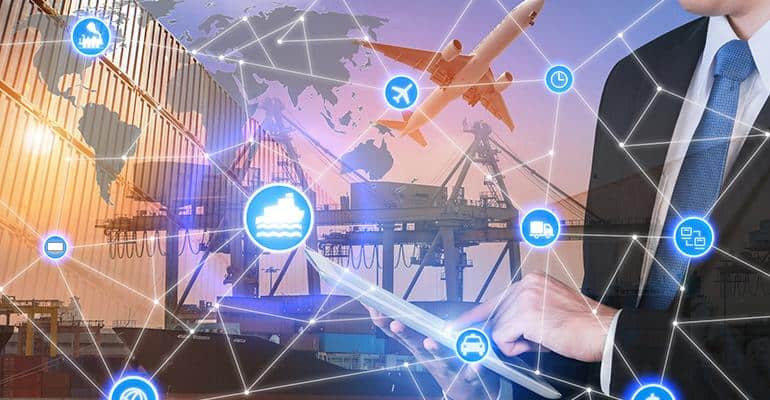Shipper-3PL Relationships Will Share Information Strategically
Part 3 of our 5-part series on Technologies Disrupting the Supply Chain
5 min read
 Murray Quibell
Jan 26, 2018 12:28:57 PM
Murray Quibell
Jan 26, 2018 12:28:57 PM
Since exhibiting at the Cargo Logistics Canada Expo and Conference in Vancouver, BC, earlier this year, we thought this would be a good time to take a closer look at some of the issues being faced by the logistics industry in 2018 and the emerging technologies that will help address them.
From Infosys’ 22nd Annual 2018 Third-Party Logistics study:
“The increased desire for visibility within the supply chain is driving increased interest in blockchain technology, which breaks each movement down into a block and documents transactions every time a shipment changes hands.”
Most often used in association with cryptocurrencies like BitCoin, blockchain is a digital, distributed, public-ledger technology designed to record transactions in a secure, tamper-proof, yet publicly-accessible way that resists tampering or modification.
So, breaking the components down a little more, we can that Blockchain is:
Blockchain was devised by a mysterious person or people known collectively as Satoshi Nakamoto, as a means of managing the distribution and financial transactions history of BitCoin. The details of which were released in a white paper released in October 2008 entitled “Bitcoin: A Peer-to-Peer Electronic Cash System”. Very little is known of the origins of the author(s) of the paper to this day.
According to FutureThinkers, blockchain technology is going to transform many industries, including banking and payments, cybersecurity, insurance, charities, voting and governance, healthcare, retail, and logistics and supply chain management.
Any industry that records transactions of any sort (financial, logistical, services-based, etc.) and that will benefit overall from having those transactions available in a public manner will likely benefit from the application of blockchain technologies.
The new platform could save the global shipping industry billions of dollars a year by replacing the current EDI- and paper-based system, which can leave containers in receiving yards for weeks.
Think of a blockchain as a series of transactions recorded in a ledger, where each transaction is encoded with the reference number and some details of the previous transaction.
If you’re interested in a particular transaction (say the date, time and manifest of a given load of cargo, as well as the carrier), that could all be encoded in a single transaction and registered on a public ‘chain’ (usually a number of computers spread out over multiple organizations).
This transaction ‘block’ would also be available on your local system (an Enterprise Resource Planning (ERP) or other management systems).
If you had the encryption password (‘key’) for your transaction, you would be able to see all the details of that transaction.
Because it was in a blockchain, you would know that a transaction is very difficult to alter or tamper with. This is because every transaction refers to the previous transaction, so every transaction in the ‘chain’ would be altered and you (and everyone else on the chain) would no longer be able to access your own transactions.
It’s sort of like balancing a checkbook – if an entry is missed, everything is out of balance.
Within a supply chain, blockchain technology could be used to:
An Example Blockchain with a Smart Contract
Watch as Ajoy Krishnamoorthy, Acumatica’s Vice-President Platform and Strategy demonstrates how Blockchain can be used to track serialized inventory around the globe using Acumatica, and RFID tags during the 2018 Acumatica Summit held in Nashville, TN (about 2 minutes):
Implementing Blockchain within a supply chain system has the potential to:
Blockchain will enable Supply Chain Managers to control the inputs to their supply chain to a much greater degree than they are able to do so today, and at a much lower cost in terms of effort, time, and money.
A number of major logistics companies have commissioned pilot projects to validate Blockchain’s potential within the industry, including:
Walmart is teaming up with IBM, Nasdaq-listed Chinese retailer JD.com, and Tsinghua University National Engineering Laboratory for E-Commerce Technologies to improve food tracking and safety in China.
Testing done by Walmart showed that the amount of time it takes to trace a package of mangoes from farm to store was reduced dramatically. The original process took days or weeks but by using blockchain technology it was down to 2 seconds.
Danish shipping giant Maersk’s trial of blockchain to track the movement of shipping cargo and freight was one of the first major enterprise test announcements. Its first live trial completed in March 2017, and it has since continued to pursue innovating with blockchain technology, including exploring its use in maritime insurance.
Also in Asia, Alibaba announced in late 2017 that it has been quietly developing an in-house private blockchain network for the past two years to track product authenticity in the supply chain and reduce counterfeiting. Geoff Jiang, Head of Ant Financial’s Innovation Lab stated that with blockchain, “we know where the product comes from, its source, and which retailer it’s coming from.”
While blockchain technology is still closely associated with cryptocurrencies, it is starting to be applied in a wider context as a public ledger.
Investment in blockchain technology has increased dramatically in the last year and the trend does not appear to be slowing down.
Many companies are furiously working towards adopting its use in SCM, including Provenance, Fluent, SKUChain, and Blockverify.
Article #1: Blockchain is Becoming a Crucial Link in the Supply Chain
Article #2: Automation and Digitization Will Shorten the Supply Chain
Article#3: Shipper-3PL Relationships Will Share Information at a Strategic Level
Article #4: Logistics is Experiencing a Talent Revolution
Article #5: 3D Printing will Add Strategic Flexibility to the Supply Chain – but When?

Part 3 of our 5-part series on Technologies Disrupting the Supply Chain

Part 4 of our 5-part series on Technologies Disrupting the Supply Chain Since Aqurus Solutions is exhibiting at the Cargo Logistics Canada Expo and...

Get Prepared for Disruption to the Supply Chain Industry as these Technologies Mature and Grow